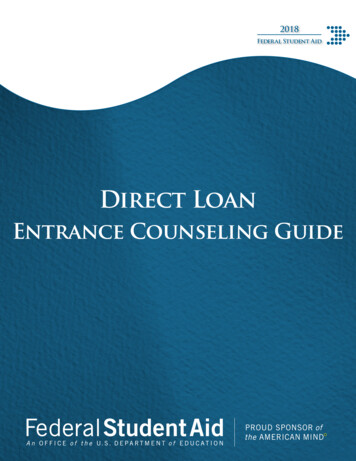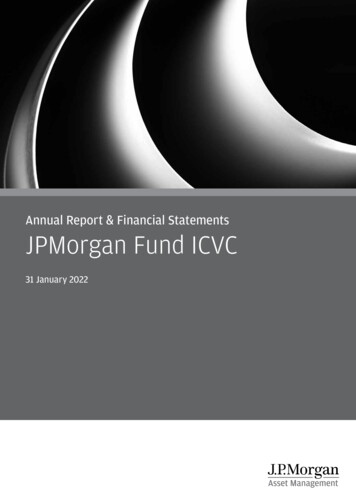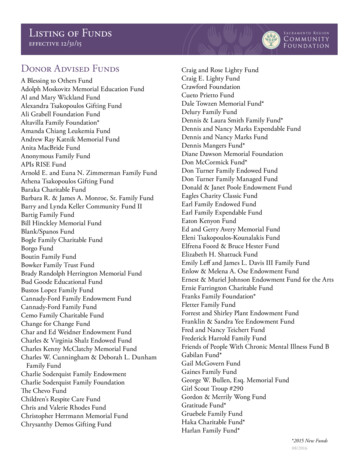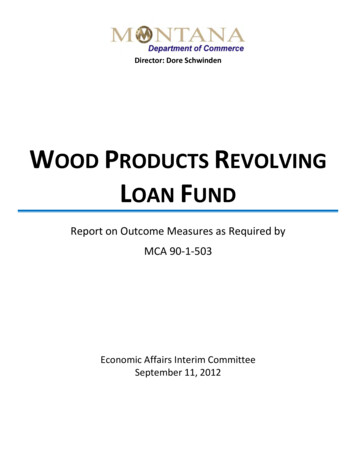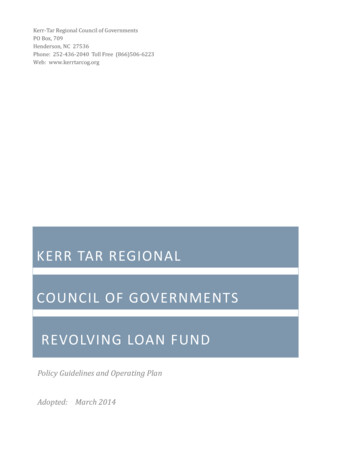
Transcription
Kerr-Tar Regional Council of GovernmentsPO Box, 709Henderson, NC 27536Phone: 252-436-2040 Toll Free (866)506-6223Web: www.kerrtarcog.orgKERR TAR REGIONALCOUNCIL OF GOVERNMENTSREVOLVING LOAN FUNDPolicy Guidelines and Operating PlanAdopted: March 2014
TABLE OF CONTENTSContentsRevolving Loan Fund Operating Overview 1Scope and Goals 1Funding 1Purpose 1Governance Structure 3Operating Parameters 4Economic Development Association Requirements 10Section I: Revolving Loan Fund Strategy 10Section II: Operational Procedures 14Loan Administration 22
Revolving Loan Fund Operating OverviewSCOPE AND GOALSThe Kerr-Tar Regional Council of Governments (COG) is the Development District serving the five countiesin the Kerr-Tar region of North Carolina. The service area includes Franklin, Granville, Person, Vance andWarren Counties. Since its creation in 1972, a primary goal of the COG has been to develop, attract, expand,and maintain better economic and employment opportunities within its five county service area. TheCOG’s Revolving Loan Fund (RLF) is an economic development tool to assist in reaching our goal. The RLFPoliy Guidelines and Operating Plan will be reviewed, at a minimum, every 5 years.FUNDINGRLF funding comes from the Economic Development Administration (EDA). In 1986, the COG Board ofDirectors authorized the COG staff to submit an application to the Economic Development Administrationfor the Title IX Revolving Loan Fund under the Long Term Economic Deterioration (LTED) Program to helpalleviate Region K’s economic adjustment need created by a poor economic base throughout the fiveeligible counties of Region K.The economic base of Franklin, Granville, Person, Vance and Warren counties is suffering from low percapita income levels, high poverty levels, low median family income levels, failing agricultural communities,and high unemployment rates.On May 14, 1987, the Economic Development Administration (EDA), of the U.S. Department of Commerce,awarded a grant to the Kerr-Tar Regional Council of Governments to establish a new EconomicDevelopment program for Region K. The EDA grant amount of 500,000 was matched by a Stateappropriation of 166,000 to establish a Revolving Loan Fund (RLF) of 666,000 to leverage other publicand private funds to stimulate new job opportunities and/or retain existing employment opportunities.All funds in the RLF shall be retained in a special account, entirely separate from all other accounts, andmay not be used for any purpose others than those eligible expenditures listed in this manual.PURPOSEThe purpose of the COG Revolving Loan Fund is to assist in the creation and/or retention of private sectorjobs within its five county service area by providing loan funds (gap financing) in conjunction with fundsfrom conventional lending institutions, from other non-traditional, gap financing sources; and, from theborrowers’ own equity financing. Loan funds will revolve perpetually, providing supplemental, short-termfinancing of business and industry proposals.Objective of the RLF program include: Page 1To reduce unemployment by creating or retaining as many job opportunities as possible;
To increase the area’s tax base by assisting with the expansion of existing industries and byencouraging new industrial and business development; To redevelop vacant land or blighted building areas in order to make them productive again; To aid in attracting other sources of capital to insure the best possible leverage of private sectordollars; To stimulate private sector capital formation and aid in small business development; To provide capital for manufacturing and service industry; To leverage the maximum number of private investment dollars, thus achieving the lowest ratiopossible of RLF dollars to private dollars; To increase per capital income through achievement of more favorable jobs to people ratio; To aid minority-owned businesses and/or female business development by providing financial andtechnical assistance; To fill financial gaps in existing local financial markets and provide capital which otherwise would notbe available for economic development, and encourage greater private sector job creation and capitalformation.Page 2
Governance StructureA Loan Review Committee (LRC) was established to assist the loan officer of the COG to evaluate andrecommend actions to the COG Board of Directors pertaining to RLF applications.The LRC will consist of ten (10) members; two (2) from each of the five (5) counties served by the Kerr-TarRegional COG. The LRC members shall be appointed by the COG Board of Directors for a two-year term. One(1) member from each county’s delegation shall have banking experience. The second county member maybe selected based on the COG Board of Directors’ desires for diversity among the LRC.This committee and the Kerr-Tar Regional COG Loan Officer will review all RLF applications, interviewapplicants to determine loan worthiness and repayment ability. Upon thorough review, the LRC shallinstruct the RLF Loan Officer to make a recommendation to the Kerr-Tar Regional COG Board of DirectorsPage 3
Operating ParametersThe following are general operating parameters of the Revolving Loan Fund.1) Eligible BorrowersEligible borrowers for RLF funds include Private, for-profit proprietorship, partnership, LLC, orcorporations.2) Eligible LoansThe RLF will make direct loans only when it has been determined that credit is not otherwiseavailable under terms and conditions that would permit accomplishment of the borrower’sproject. The RLF will not make loan guarantees. RLF participation in a project must not displacecommercial lenders. The RLF Loan Officer is responsible for determining that a borrower meetsthis requirement.For each loan, the eligible borrower must agree to create new jobs and/or save existing jobs withina two (2) year period. Eligible loan purposes include direct loans for:a.b.c.d.e.f.g.h.Land and Site Improvements – including land acquisition, engineering, legal, grading,testing, site mapping, and related costs associated with acquisition and preparation ofland;Building Improvements – including real estate, engineering, architectural, legal, andrelated costs associated with acquisition, construction, rehabilitation of buildings, anddemolitions;Purchase of Machinery and Equipment – including delivery, installation, engineering,architectural, legal, insurance, and related costs associated with acquisition andinstallation of machinery and equipment;Other costs contributing directly to the value of fixed assets, such as sales and use taxes,and interest on interim construction financing;Adequate contingency reserves;Start-up and working capital;Infrastructure costs;Relocation expenses as per Uniform Relocation Assistance Act.3) Ineligible Borrowers Page 4Land banking/real estate Investment Company;Speculate building and Development Company;
Passive investment company, e.g. stocks, bonds, high-yield instruments; Lending institutions; Non-profit organizations, associations, and corporations.4) Ineligible LoansThe RLF cannot make loans for the following:a.Creation of highly seasonal jobs;c.Refinancing of existing loan from other lenders or debt consolidation;b.d.e.f.g.Subsidization of interest payment on existing loans;Provision of mandatory equity contribution required of borrowers for other Federal loanprograms;Loans to itself (the COG) or to a subsidiary;Loans made outside the five county service area.The COG shall not make loan funds available to a business entity if the owner of suchentity or any owner of an interest in such entity is related by blood, marriage, law orbusiness arrangement to an officer or employee of the COG or any member of the Board ofDirectors, or a member of the Loan Review Committee. The Board Members of the COGand Loan Review Committee are ineligible to apply for or receive RLF loans. Thisrestriction continues for a period of two year from the date of termination from either theCOG Board or Loan Review Committee.5) Loan Guidelines:Due to the limited amount of RLF dollars, the COG has set a maximum amount in an attempt to spreadthe funds available throughout the eligible counties of the region to achieve the economic objectives ofthe RLF program. The following guidelines shall apply in processing RLF loans:1.2.3.4.5.6.Page 5Total project cost will be unlimited;The projected average size of a loan under the RLF program is estimated to be 70,000;The maximum RLF loan participation granted a borrower shall not exceed 200,000; or75% of total Project Cost, whichever is the lesser;The minimum RLF participation will be 25,000;Maximum participation by RLF will be evaluated on a project-by-project basis taking intoconsideration such factors as: whether application is for project continuation or newstart-up business, along with financial stability of the applicant;Applicant must submit a letter from a commercial bank, savings and loan, or other privatelender that reflects information on conventional sources of financing are not available, theamount of the loan application, and why it is denied;
7.“To leverage private investment: a minimum ratio of two private dollars is required forloan portfolio as to whole.”6) Job Creation RequirementsA requirement for lending RLF funds is that the equivalent of at least one direct full-time 40 hoursper week job is to be created/retained for every 25,000 in RLF funds. The borrower will have twoyears from the date of loan closing to create/retain the committed number of jobs or a pro-rataamount of the RLF funds must be returned to the RLF fund.The RLF program will attempt to fulfill a goal of directing 15 percent of new jobs created to thelong-term unemployed. In attempts to achieve this goal, there will be coordination with theregional WIA programs, local community colleges, and the NC Division of Workforce Solutions.Priority will be given to loan applicant that meets the needs of the targeted population byproviding a large number of permanent jobs and gaining opportunities for unskilled and semiskilled workers.7) Required Loan Documentation1.A “letter of denial” from a bank. The Kerr-Tar Regional Council of Governments (COG) RLFProgram is designed to fill gaps in existing local financial markets. The RLF program is not asubstitute for conventional lending sources. Before filing an RLF application, you must firstformally apply for the loan with a bank. If the bank declines to participate in full or in part, youmay then apply for a loan under the RLF program. If the bank denies your request, it can provideyou with a letter of denial. A letter of denial must accompany your RLF application. The letter ofdenial must state the loan amount requested from the bank and the specific reasons that the loanrequest was denied. The letter of denial should match the loan being requested from the COG indollar amount, terms and collateral being offered.2.3.A completed Personal Financial Statement.A Business Plan.4.A Resume of the loan applicant(s). The resume should adequately summarize the businessand professional experience of the applicant for the last 10 years. Resumes for all administrativeand operational management personnel, principals in the business, and persons guaranteeing theloan should also be included.5.Latest Balance Sheet and Profit/Loss Statements for last three years (for existingbusinesses).6.Annual Balance Sheet and Profit/Loss Statements for the last three years (for existingbusinesses).7.Page 6A 24-month cash flow projection and analysis (for existing and proposed businesses).
8.Information on all of the applicant’s parents, subsidiaries and/or affiliated enterprises (ifapplicable). The required information includes: 1.) Name, address, nature of business and extent ofaffiliation; 2.) Latest balance sheet and profit/loss statement (not over 90 days old); and 3.) Annualbalance sheet and profit/loss statements for last three years.9.A list of any business related equipment that is owned by the applicant and has a value ofover 100.10.A list of the fixed assets to be purchased with the loan proceeds (if applicable) along withan approximate value of each item.11.A list of prospective clients (if applicable).12.A signed “Certificate of Assurances”. This form certifies that the applicant and/or anybeneficiary of the loan will comply with all appropriate state and federal laws as they relate to theapplication and the acceptance and use of federal funds.13.Hazard and flood insurance with other forms of insurance as required by the COG if loan isapproved.14.A security deposit check for 1,000. The deposit will pay for the loan processing andattorney fees. If the loan request is denied, the security deposit will be returned to the applicant.15.In addition, credit reports, appraisal reports (if applicable) and environmentalreviews (if applicable) will be required. There may be other exhibits pertinent to the RLF loanapplication that will be filled out by the COG such as a standard credit analysis.16.Other information deemed necessary in the review and evaluation of the loan application.7) Lending Policies:The RLF financing policies that will be used to address the financing problems and gaps in the areainclude the following:a.b.The terms for repayment of loans will be made on a project-by-project basis. The shortestfeasible term will be made available to insure rapid return of RLF funds in order to assistmore borrowers.Terms for fixed asset loans will not be greater than the weighted average useful life of thedepreciable fixed assets of the project. Generally, maximum loan terms based on purposeand collateral will be offered as follows:Land and Building – 15 years****Machinery and Equipment –10 yrs new / 7 yrs used or useful life documented bysome non affiliated source with a maximum of 10 yearsWorking Capital – 5 yearsThe COG Board of Directors, upon recommendation from the Loan Review Committee,may make exceptions to these guidelines.Page 7
c.d.e.f.g.h.i.j.k.Page 8The RLF will have a solid but flexible payback policy. After evaluation of specificcircumstances, the RLF Advisory Committee may approve a temporary moratorium onloan payment.The minimum interest rate an RLF Recipient may charge is four (4) percentage pointsbelow the lesser of the current money center prime interest rate quoted in the Wall StreetJournal, or the maximum interest rate allowed under State law. In no event shall theinterest rate be less than the lower of four (4) percent or 75 percent of the prime interestrate listed in the Wall Street Journal. (2) Exception. Should the prime interest rate listed inthe Wall Street Journal exceed fourteen (14) percent, the minimum RLF interest rate is notrequired to be raised above ten (10) percent if doing so compromises the ability of theRLF Recipient to implement its financing strategy.In the determination of collateral requirements the COG Board may consider the meritsand potential economic benefits of each loan request. The COG may secure a first, second,or third lien on available collateral. The lien position of the COG may be subordinate andinferior to lien or liens securing other loans made in connection with a project.When the purpose of a loan is for working capital, the COG will normally obtain collateralsuch as liens on inventories, accounts receivable, fixed assets and/or other available assetsof the borrower. Such liens will be properly recorded as prescribed by applicable stateand local Uniform Commercial Code (UCC) laws. Ordinarily, COG funds will not be used totake a subordinate lien position or other Federal, State or Local loan programsparticipating in the project.The COG will ordinarily require security in the form of the assignment of patents andlicenses; the acquisition of hazard, liability and other forms of insurance including floodinsurance, as appropriate, performance bonds, and such other additional security as isdeemed necessary to mitigate the RLF’s exposure. Kerr-Tar Regional Council ofGovernments, as administrator of the RLF, must be shown as a lender losspayee/mortgagee by endorsement on insurance.Life insurance policies on key individuals with benefits assigned to the COG may berequired on business owners of closely held corporations, partnerships orproprietorships, where the continuing success of the business is dependent on such keyindividuals.Personal guarantees from a borrower’s principal owners (partnerships andproprietorships) and their spouses, to the extent permitted by law, making them jointlyand severally liable for the loan, will be required. In case of a corporate borrower, inaddition to corporate asset, members of the Board of Directors holding twenty percent ormore of the corporation’s outstanding common stock or twenty percent or more of thecorporation’s voting stock and their spouses (if held jointly), will guarantee loans.Security interest on equipment, machinery, office furniture, fixtures and personalproperty owned now or acquired from the proceeds of the loan may be required;In the determination of collateral requirements, the COG Board of Directors may considerthe merits and potential economic benefits of each request. When appropriate, the RLF
l.program may require security in the form of assignments of leases, contracts, andcommissions. Additional security as the lender determines may be necessary to supportthe RLF’s exposureShould it be determined that it is necessary or desirable to take actions to protect orfurther the interests of the RLF, COG shall act to sell, collect, liquidate or otherwise recoveron loans extended by the RLF in accordance with the legal rights of the COG, other lenders,and the RLF borrower.m. The COG may modify the terms under which RLF financing has been extended to enhancethe ability of the RLF to achieve program objectives.Page 9
Economic Development Administration RequirementsBecause the United States Economic Development Administration (EDA) provides funding support to theKerr-Tar Regional Council of Governments (COG) Revolving Loan Fund the following requirements aremandatory and compliance is a standard requirement for any loan funds.Preface: Within RLF Plans, EDA Regulations should work “hand in glove” with local policies, strategies andobjectives to guide the management of RLF funds. To this end, the COG RLF Operating Plan includes theEDA Regulations noted below, which are included exactly as written in Chapter 307.7 Subpart B: SpecialRequirements for Revolving Loan Funds and Use of Grant Funds.SECTION I: REVOLVING LOAN FUND STRATEGYName of organization: The Kerr-Tar Regional Council of GovernmentsList of Counties Comprising the Lending Territory:Franklin County and the municipalities of Bunn, Franklinton, Louisburg, and YoungsvilleGranville County and the municipalities of Butner, Creedmoor, Oxford, Stem, and StovallPerson County and the municipality of RoxboroVance County and the municipalities of Henderson, Kittrell, and MiddleburgWarren County and the municipalities of Macon, Norlina, and WarrentonDescription of Comprehensive Economic Development StrategyIn March, 1975, the United States Department of Commerce’s Economic Development Administration(EDA) designated the geographic area served by the Kerr-Tar Regional Council of Governments (COG) as anEconomic Development District (EDD). As the administrative body of the Kerr-Tar EDD, the COG receiveseconomic development planning funds from EDA and is eligible to participate in the development andadministration of EDA-funded projects in the region. The COG is also responsible for preparation andmaintenance of a Comprehensive Economic Development Strategy (CEDS) for the EDD.A CEDS is the result of a regional economic planning process designed to guide the economic growth of theregion. The purpose of the CEDS is to create a process that will “create jobs, foster more stable anddiversified economies, improve living conditions and provide a mechanism for coordinating the efforts ofpeople, organizations, local governments, and private industry concerned with economic development”. ACEDS is also necessary to quality for EDA assistance with development.Page 10
The COG’s 2012 CEDS lists the following goals for the regions economic development:Goal 1: Build on the Region’s Competitive Advantage and Leverage the Marketplace1. Develop outdoor recreational opportunities which are unique to the region2. Support existing and emerging industry clusters in the region3. Support and strengthen entrepreneurial development in the region4. Prepare the region’s workforce for sustainable employmentGoal 2: Establish & Maintain a Robust Regional Infrastructure1. Improve access to broadband infrastructure for manufacturers, businesses, downtowns, andresidential areas2. Continue to work through the Kerr-Tar RPO to develop long-range transportation plans andadvocate for local projects3. Develop plans for equitable and affordable housing.Goal 3: Create Revitalized & Vibrant Communities1. Promote healthy, walkable communities in the Region2. Promote downtowns in the region as cultural centers3. Promote healthy lifestyles and obesity reductionGoal 4: Develop Healthy and Innovative People1. Foster development, recruitment and retention of a skilled workforce2. Develop ways to create an environment that fosters entrepreneurial development and growth3. Expand recreation and fitness activities though NC Lakes District Recreation PlanBusiness Development Objectives1. Create new job opportunities in order to increase per capital income, to reduce unemployment,and to increase the tax base derived from economic activities.2. Improve economic opportunity and living standards for the citizens of the Kerr-Tar region.3. Improve the opportunities of the unemployed, underemployed, and minority persons.4. . Support and strengthen entrepreneurial development in the region.RLF Financing Strategy307.15 Prudent management of Revolving Loan Funds.(A) Accounting principles.(1) RLFs shall operate in accordance with generally accepted accounting principles (‘‘GAAP’’) as ineffect from time to time in the United States and the provisions outlined in OMB Circular A–133and the Compliance Supplement, as applicable.Page 11
(2) In accordance with GAAP, a loan loss reserve may be recorded in the RLF Recipient’s financialstatements to show the fair market value of an RLF’s loan portfolio, provided this loan loss reserveis non-funded and represents non-cash entries.(B) Loan and accounting system documents.(1) Within sixty (60) days prior to the initial disbursement of EDA funds, an independentaccountant familiar with the RLF Recipient’s accounting system shall certify to EDA and the RLFRecipient that such system is adequate to identify, safeguard and account for all RLF Capital,outstanding RLF loans and other RLF operations.(2) Prior to the disbursement of any EDA funds, the RLF Recipient shall certify that standard RLFloan documents reasonably necessary or advisable for lending are in place and that thesedocuments have been reviewed by its legal counsel for adequacy and compliance with the termsand conditions of the Grant and applicable State and local law. The standard loan documents mustinclude, at a minimum, the following:(i) Loan application;(ii) Loan agreement;(iii) Board of directors’ meeting minutes approving the RLF loan;(iv) Promissory note;(v) Security agreement(s);(vi) Deed of trust or mortgage (as applicable);(vii) Agreement of prior lien holder (as applicable); and(viii) Signed bank turn-down letter demonstrating that credit is not otherwise availableon terms and conditions that permit the completion or successful operation of the activityto be financed. EDA will permit the RLF Recipient to accept alternate documentation onlyif such documentation is allowed in the Recipient’s EDA-approved RLF Plan.(C) Interest rates—RLF Financing Policies(1) General rule. An RLF Recipient may make loans to eligible borrowers at interest rates andunder conditions determined by the RLF Recipient to be appropriate in achieving the goals of theRLF. The minimum interest rate an RLF Recipient may charge is four (4) percentage points belowthe lesser of the current money center prime interest rate quoted in the Wall Street Journal, or themaximum interest rate allowed under State law. In no event shall the interest rate be less than thelower of four (4) percent or 75 percent of the prime interest rate listed in the Wall Street Journal.(2) Exception. Should the prime interest rate listed in the Wall Street Journal exceed fourteen (14)percent, the minimum RLF interest rate is not required to be raised above ten (10) percent if doingso compromises the ability of the RLF Recipient to implement its financing strategy.(D) Private leveraging.(1) RLF loans must leverage private investment of at least two dollars for every one dollar of suchRLF loans. This leveraging requirement applies to the RLF portfolio as a whole rather than toPage 12
individual loans and is effective for the duration of the RLF’s operation. To be classified asleveraged, private investment must be made within twelve (12) months of approval of an RLF loan,as part of the same business development project, and may include:(i) Capital invested by the borrower or others;(ii) Financing from private entities; or(iii) The non-guaranteed portions and ninety (90) percent of the guaranteed portions ofthe U.S. Small Business Administration’s 7(A) loans and 504 debenture loans.(2) Private investments shall not include accrued equity in a borrower’s assets.(E) RLF certification course. EDA may establish a mandatory RLF certification program to enhance RLFRecipients’ ability to administer RLF Grants in a prudent manner. If so required by EDA, the RLF Recipientmust satisfactorily complete this program, and may consider the cost of attending the certification coursesas an administrative cost, provided the requirements set forth in § 307.12 are satisfied.[71 FR 56675, Sept. 27, 2006, as amended at 73 FR 62868, Oct. 22, 2008; 75 FR 4264, Jan. 27, 2010]307.17 Uses of capital.(A) General. RLF Capital shall be used for the purpose of making RLF loans that are consistent with an RLFPlan or such other purposes approved by EDA. To ensure that RLF funds are used as intended, each loanagreement must clearly state the purpose of each loan.(B) Restrictions on use of RLF Capital. RLF Capital shall not be used to:(1) Acquire an equity position in a private business;(2) Subsidize interest payments on an existing RLF loan;(3) Provide for borrowers’ required equity contributions under other Federal Agencies’ loanprograms;(4) Enable borrowers to acquire an interest in a business either through the purchase of stock orthrough the acquisition of assets, unless sufficient justification is provided in the loandocumentation. Sufficient justification may include acquiring a business to save it from imminentclosure or to acquire a business to facilitate a significant expansion or increase in investment witha significant increase in jobs. The potential economic benefits must be clearly consistent with thestrategic objectives of the RLF;(5) Provide RLF loans to a borrower for the purpose of investing in interest bearing accounts,certificates of deposit or any investment unrelated to the RLF; or(6) Refinance existing debt, unless:(i) The RLF Recipient sufficiently demonstrates in the loan documentation a ‘‘soundeconomic justification’’ for the refinancing (e.g., the refinancing will support additionalcapital investment intended to increase business activities). For this purpose, reducing therisk of loss to an existing lender(s) or lowering the cost of financing to a borrower shallnot, without other indicia, constitute a sound economic justification; orPage 13
(ii) RLF Capital will finance the purchase of the rights of a prior lien holder during aforeclosure action which is necessary to preclude a significant loss on an RLF loan. RLFCapital may be used for this purpose only if there is a high probability of receivingcompensation from the sale of assets sufficient to cover an RLF’s costs plus a reasonableportion of the outstanding RLF loan within eighteen (18) months following the date ofrefinancing.(C) Compliance and Loan Quality Review. To ensure that the RLF Recipient makes eligible RLF loansconsistent with its RLF Plan or such other purposes approved by EDA, EDA may require an independentthird party to conduct a compliance and loan quality review for the RLF Grant every three (3) years. TheRLF Recipient may undertake this review as an administrative cost associated with the RLF’s operationsprovided the requirements set forth in § 307.12 are satisfied.(D) Use of In-Kind Contributions. In- Kind Contributions may satisfy Matching Share requirements whenspecifically authorized in the terms and conditions of the RLF Grant and may be used to provide technicalassistance to borrowers or for eligible RLF administrative costs.[73 FR 62868, Oct. 22, 2008 as amended at 75 FR 4265, Jan. 27, 2010]SECTION II: OPERATIONAL PROCEDURESA. Organizational StructureThe Kerr-Tar Regional Counci
REVOLVING LOAN FUND Policy Guidelines and Operating Plan . Adopted: March 2014 . Kerr-Tar Regional Council of Governments PO Box, 709 Henderson, NC 27536 Phone: 252-436-2040 Toll Free (866)506-6223 Web: www.kerrtarcog.org . TABLE OF CONTENTS Contents .



